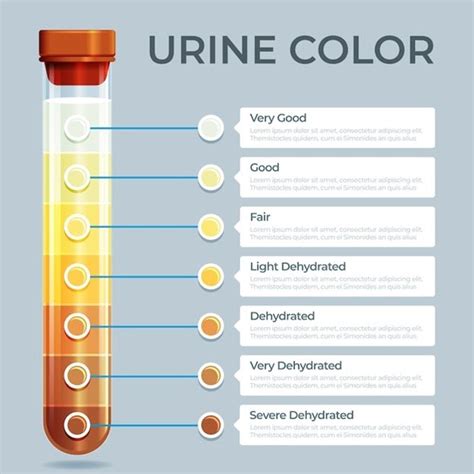Intro
Check your urine colour to gauge dehydration levels. Dark yellow or amber hues indicate severe dehydration, while pale yellow signals optimal hydration, helping monitor body water balance and overall health.
The colour of our urine can tell us a lot about our body's hydration levels. When we drink enough water, our urine is typically pale yellow or clear, indicating that our body is well-hydrated. However, when we don't drink enough water, our urine can become darker and more concentrated, indicating dehydration. This is because our kidneys are trying to conserve water by reducing the amount of urine produced, resulting in a more concentrated and darker-coloured urine.
Dehydration can occur when we lose more fluids than we take in, and it can be caused by a variety of factors such as not drinking enough water, exercising or engaging in physical activity, or having a medical condition that affects fluid balance. Severe dehydration can lead to serious health problems, including kidney damage, heat stroke, and even death. Therefore, it's essential to monitor our urine colour and take steps to stay hydrated, especially during hot weather or when engaging in physical activity.
The importance of monitoring urine colour cannot be overstated. By paying attention to the colour of our urine, we can take early action to prevent dehydration and its associated health problems. Moreover, monitoring urine colour can also help us identify underlying medical conditions that may be affecting our fluid balance. For example, if our urine is consistently dark or tea-coloured, it could be a sign of a kidney or liver problem that needs medical attention.
Understanding Urine Colour

Urine colour is determined by the amount of waste products, such as urea, that are present in the urine. When we drink enough water, our kidneys are able to dilute these waste products, resulting in a pale yellow or clear urine. However, when we don't drink enough water, these waste products become more concentrated, resulting in a darker-coloured urine. The colour of our urine can also be affected by other factors, such as the presence of certain medications, foods, or medical conditions.
What Do Different Urine Colours Mean?
The colour of our urine can provide valuable information about our body's hydration levels and overall health. Here are some common urine colours and what they may indicate: * Clear or pale yellow: Well-hydrated * Dark yellow or amber: Mildly dehydrated * Honey-coloured or brown: Moderately dehydrated * Tea-coloured or reddish-brown: Severely dehydrated * Green or blue: May indicate the presence of certain medications or medical conditionsFactors That Affect Urine Colour

Several factors can affect the colour of our urine, including:
- Medications: Certain medications, such as antibiotics or laxatives, can change the colour of our urine.
- Foods: Foods that are high in pigment, such as beets or rhubarb, can temporarily change the colour of our urine.
- Medical conditions: Certain medical conditions, such as kidney or liver disease, can affect the colour of our urine.
- Dehydration: As mentioned earlier, dehydration can cause our urine to become darker and more concentrated.
How to Stay Hydrated
Staying hydrated is essential for maintaining good health, and there are several ways to do so: * Drink plenty of water: Aim to drink at least eight glasses of water per day. * Eat hydrating foods: Foods that are high in water content, such as watermelon or cucumbers, can help contribute to our daily hydration needs. * Avoid sugary drinks: Sugary drinks, such as soda or sports drinks, can actually dehydrate us further. * Monitor urine colour: By paying attention to the colour of our urine, we can take early action to prevent dehydration.Benefits of Monitoring Urine Colour

Monitoring urine colour can provide several benefits, including:
- Early detection of dehydration: By paying attention to the colour of our urine, we can take early action to prevent dehydration and its associated health problems.
- Identification of underlying medical conditions: Consistently dark or tea-coloured urine can be a sign of an underlying medical condition that needs medical attention.
- Improved overall health: By staying hydrated and monitoring urine colour, we can improve our overall health and reduce our risk of developing certain health problems.
Common Mistakes to Avoid
When it comes to monitoring urine colour, there are several common mistakes to avoid: * Not drinking enough water: Failing to drink enough water can lead to dehydration and a range of associated health problems. * Ignoring changes in urine colour: Failing to pay attention to changes in urine colour can mean missing early warning signs of dehydration or underlying medical conditions. * Not seeking medical attention: If we notice consistent changes in urine colour or other symptoms of dehydration or underlying medical conditions, it's essential to seek medical attention.Conclusion and Next Steps

In conclusion, monitoring urine colour is a simple and effective way to stay hydrated and identify potential health problems. By paying attention to the colour of our urine and taking steps to stay hydrated, we can improve our overall health and reduce our risk of developing certain health problems. If we notice consistent changes in urine colour or other symptoms of dehydration or underlying medical conditions, it's essential to seek medical attention.
Final Thoughts
In final thoughts, monitoring urine colour is an important aspect of maintaining good health. By understanding what different urine colours mean and taking steps to stay hydrated, we can improve our overall health and reduce our risk of developing certain health problems. Remember to drink plenty of water, eat hydrating foods, and avoid sugary drinks to stay hydrated and healthy.What is the normal colour of urine?
+The normal colour of urine is pale yellow or clear.
What does dark yellow or amber urine indicate?
+Dark yellow or amber urine indicates mild dehydration.
What should I do if I notice consistent changes in urine colour?
+If you notice consistent changes in urine colour, it's essential to seek medical attention to rule out any underlying medical conditions.
We hope this article has provided you with a comprehensive understanding of the importance of monitoring urine colour. If you have any further questions or concerns, please don't hesitate to comment below. Share this article with your friends and family to help them stay hydrated and healthy. Take the first step towards improving your overall health by paying attention to the colour of your urine and taking steps to stay hydrated.
